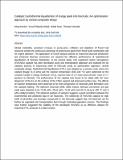Catalytic hydrothermal liquefaction of orange peels into biocrude: An optimization approach by central composite design

View/
Date
2023-08Author
Kariim, Ishaq
Waidi, Yusuf
Swai, Hulda
Kivevele, Thomas
Metadata
Show full item recordAbstract
Global instability, persistent increase in pump-price, inflation and depletion of fossil fuel resources amidst the continuous discharge of greenhouse gases from fossil fuels combustion call for urgent attention. The application of novel catalyst towards an improved biocrude production and enhanced biomass conversion are required for effective performance of hydrothermal liquefaction of biomass feedstocks. In the present study, iron supported carbon nanospheres (Fe/CNSs) catalyst has been developed using wet impregnation approach and explored for its catalytic potency in improving yield of biocrude using an optimization approach; central composite design. Hydrothermal liquefaction (HTL) was adopted as a process route where the catalyst dosage (3–6 wt%) and the reaction temperature (330–430 °C) were optimized on the constant weight of orange feedstock (10 g), reaction time of (15 mins) and solvents’ ratio of 3:1 (acetone to ethanol). The performance of the catalyst was found to be aided with the even dispersion of the Fe on the surfaces of the CNSs support and improved surface area. The effects of reaction temperature were observed to be more progressive on biocrude yield formation over the catalyst loading. The optimum biocrude yield, solid residue, biomass conversion and gas yield were obtained to be 71.09 wt%, 28.18 wt%, 71.82 wt% and 40.14 mL/g at 430 °C and 3 wt% catalyst loading. The obtained analysis of variance suggests a good correlation between the experimental and predicted data in all responses. The selectivity of Fe/CNSs catalyst to high yield of phenolics and aromatic compounds in the biocrude suggest that, the biocrude can be further be upgraded into transportation fuel through hydrodeoxygenation process. The findings have further suggested the viability of the developed Fe/CNSs as an effective catalyst for improved HTL products in a batch reactor.
URI
https://doi.org/10.1016/j.jaap.2023.106032https://dspace.nm-aist.ac.tz/handle/20.500.12479/2014
